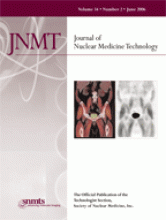
VALERIE R. CRONIN, CNMT, FSNMTS
As I reflect on my remaining time as president and look to the future of SNMTS, two major themes become apparent.
First, what we have achieved is nothing short of stunning. Our officers have deliberated—and support—baccalaureate degree entry-level requirements for nuclear medicine technologists (NMTs) and the development of a master's degree–level nuclear medicine practitioner (NMP). These two initiatives will help us build our future, ensuring continued success for technologists.
We know that new advancements in multimodal imaging and therapy—and increasing demands for accountability—require increasing levels of skill and knowledge not easily delivered within the current structure of entry-level educational programs. Technologists must achieve competence in the molecular sciences and must continue to be technically competent, well-rounded, critical thinkers. To achieve professional status in the eyes of the federal government, the profession must require a bachelor's degree for entry level and a commitment to lifelong learning. SNMTS would like to have new standards in place by 2010, with all NMT programs applying the baccalaureate degree by 2015. Subgroups have been appointed to focus on programmatic transition, core curriculum, collaboration with external stakeholders, and outreach to the molecular imaging/nuclear medicine community.
While there may be conflicted feelings about entry-level requirements, much excitement has been voiced over developing an advanced level of clinical practice for NMTs. Over the past years, many NMTs have taken on roles in the clinical practice setting that are generally considered over and above the entry-level practice domain. NMTs must acquire new skills to keep up with technically complex SPECT, PET, and CT imaging in the new world of molecular imaging. We are now discussing related competencies and curricular requirements for developing a master's degree–level NMP program. This will open the doors to a new level of opportunity for SNMTS members.
These accomplishments are not attributable to any individual president—they are far too great to be claimed by any one person—but rather are the product of a talented and committed community of volunteers. I do, however, want to especially recognize the efforts of William L. Hubble, CNMT, RT(R)(N)(CT), co-chair of the Entry-Level Task Force, and Martha W. Pickett, CNMT, FSNMTS, chair of the Advanced Practice Task Force.
However, it would be a mistake to discount the challenges that remain. In particular, we must now carry both these initiatives forward. In addition, we must continue our fight for national initiatives to promote federal minimum standards for nuclear medicine and radiologic technologists and radiation therapists, for insurance coverage and reimbursement issues, and for increased funding for key medical radioisotope production and basic science research at the Department of Energy.
If there's anything I've learned over the past 365 days of hard work, it's that our profession remains exciting, ever changing, and ever challenging. The profession and molecular imaging diagnostic breakthroughs are evolving together, and we see the increased importance of developing well-rounded technologists who must work in PET/CT, SPECT/CT, research, and information technology and learn more about cross-sectional anatomy, contrast media, and instrumentation. I want to thank the many individuals who continually look to the future and plan and develop relevant educational programs for SNM's Learning Center.
I am deeply honored to have had the opportunity to serve SNMTS, and I remain optimistic about its future. The future holds known and unexpected challenges, and we must plan effectively to meet them. My successor—and a respected colleague—Scott Holbrook, CNMT, FSNMTS, is superbly qualified to lead this effort. He will need the support and assistance of all who are a part of the molecular imaging/nuclear medicine profession.
I plan on remaining active with the Technologist Section, serving on the Education and Research Foundation. I will also be transitioning my role from director to vice president of imaging services with the Catholic Health System of Western New York and continuing work on my master's degree. The skill and energy of our community of people alone is reason for optimism about the future of SNMTS. Together, we are building on a foundation of excellence.







